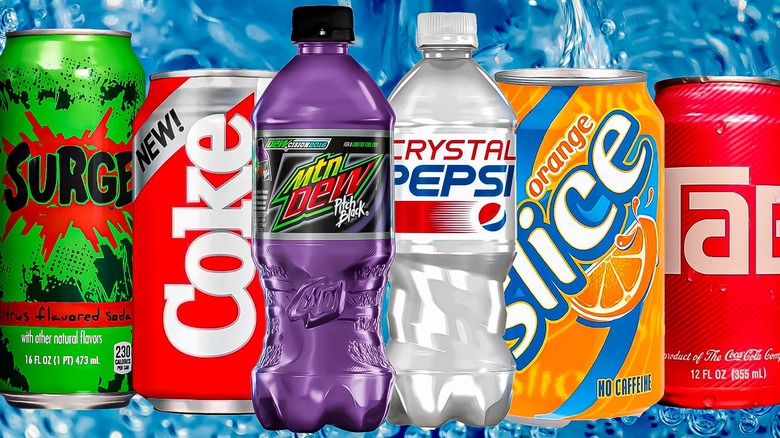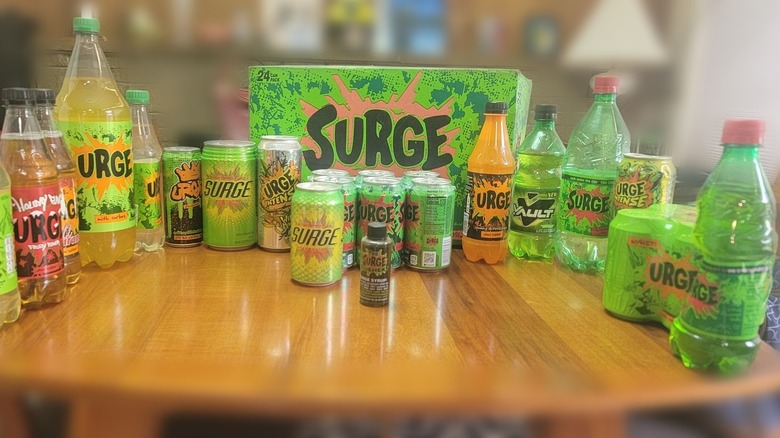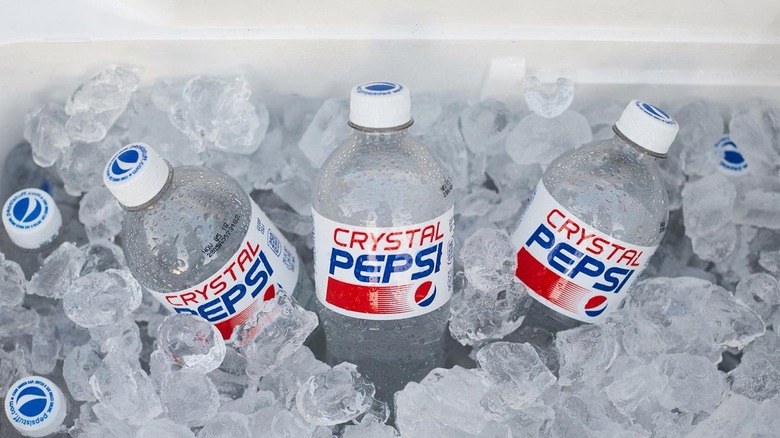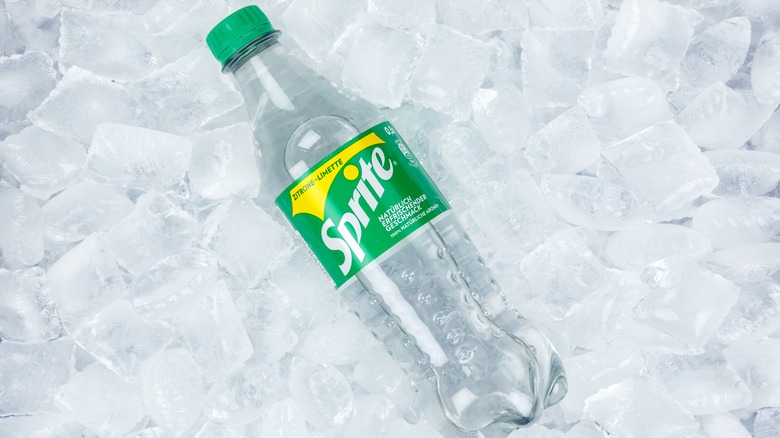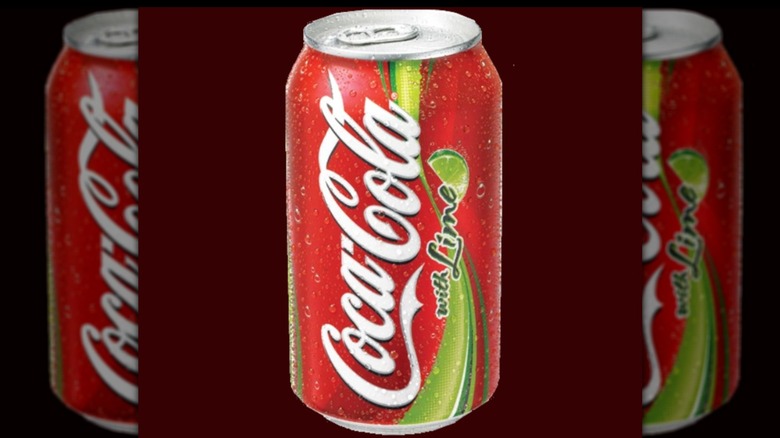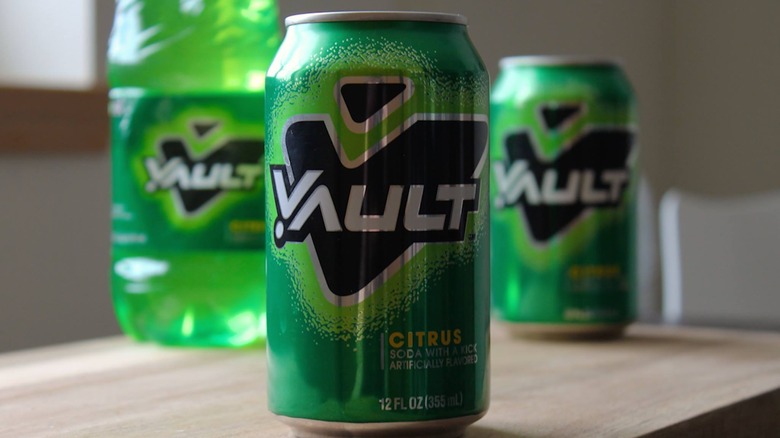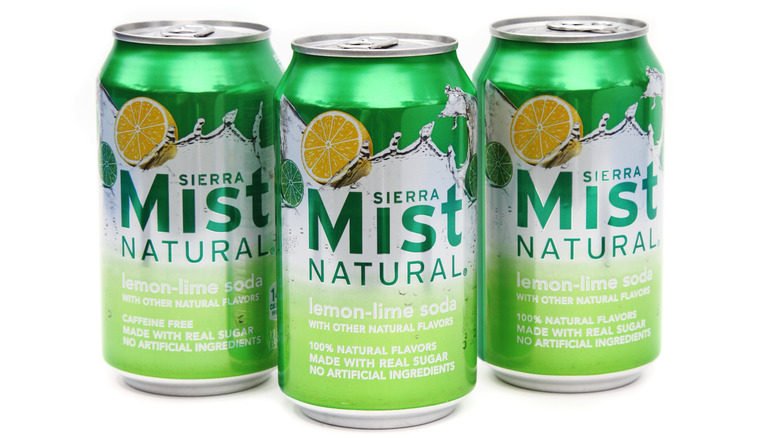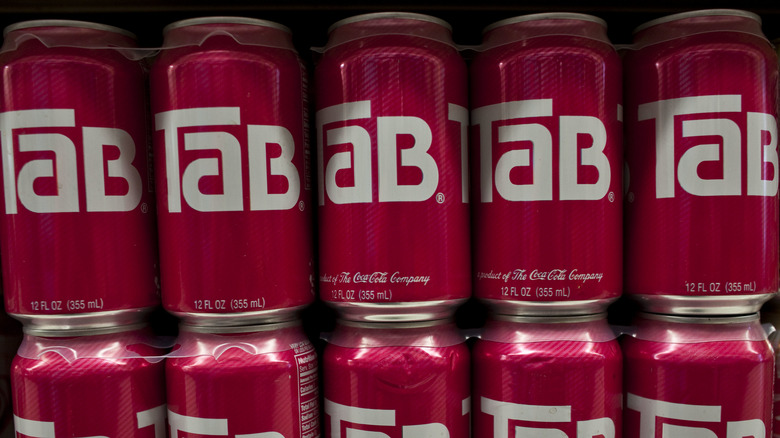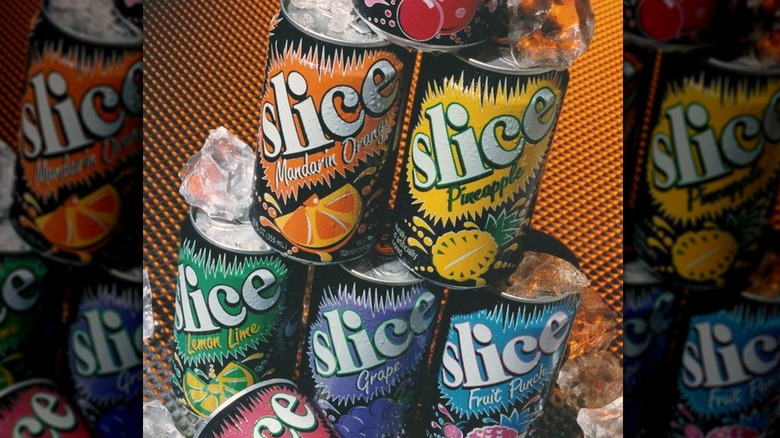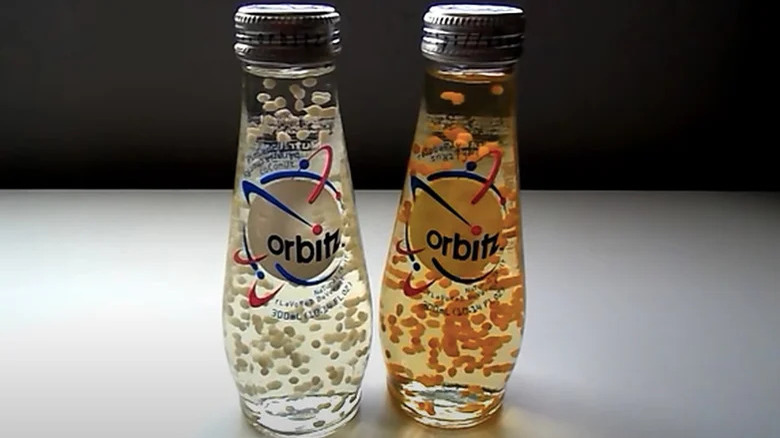17 Discontinued Sodas We Aren't Getting Back
Soda is a drink that has always told a lot about the culture of the day and how people live. These fizzy, sugary beverages are a treat that people use for leisure, celebration, and to satisfy their sweet tooth. Carbonated beverages date back to the 1700s, and this technology has grown into a virtual must-have drink. People have their soda of choice, and companies spend hundreds of millions of dollars each year to keep their brands on consumers' minds.
The brands become so iconic that people proudly wear soda logos on their clothing. While some come and go, the likes of Coca-Cola and Pepsi remain at the top of the mountain. However, throughout the years, even the giants have had some big swings and misses when it comes to products that they released. Other companies missed the mark so badly that they got out of the business entirely. Some defunct beverages are missed sorely by consumers, to the point that there are active petitions for their return. An examination of obsolete sodas tells a lot about the sensibilities of the consumer over the years. Some were great ideas that ran their course, while others left customers scratching their heads as soon as they were released. This guide will discuss 15 of these discontinued sodas that we aren't getting back.
1. Surge
Surge probably tops the list of discontinued sodas that people miss fondly. It was the cool soda of the '90s, and you probably knew about it or drank it whether you grew up in this era or were already of age. This is a citrus-based beverage produced by Coca-Cola that was finally discontinued in 2003. Declining sales led to the soda's discontinuation, but to this day there are social media groups and petitions with the intent of bringing it back.
The taste is comparable to sodas like Mello Yello and Mountain Dew, but Surge marketed itself as being extreme. It wasn't an energy drink in the way that Red Bull is, but it was definitely the soda you turned to when you wanted a caffeine kick. Everything about Surge epitomized the '90s. It was the soda choice of teenagers who roamed the streets with their friends, skateboarded, and wore Airwalks. Surge had plenty of urban legends attached to it, which were magnified in a pre-Web 2.0 world.
The legend of Surge lives on; besides the aforementioned petitions, online subgroups exist for the soda and it has enjoyed periodic limited releases throughout the years. Today, you'd be hard-pressed to find a bottle or can, but the soda can be found at Burger King locations in the Coca-Cola Freestyle soda machines. Though Surge remains in the hearts and minds of people who remember the movement that it was during an uncanny decade.
2. Crystal Pepsi
Crystal Pepsi is another '90s creation and cultural phenomenon. However, rather than being heralded as a soda everyone wants back, Crystal Pepsi is frequently cited as one of the worst business failures of all time. The soda flopped spectacularly; it was released in 1992 and officially discontinued in 1994. Its concept was simple enough –- people love Pepsi and drink it more than almost every other soda in the world. What if we made it clear?
Pepsi sunk ample marketing dollars into Crystal Pepsi, including Super Bowl commercials and ads featuring astronauts, futuristic themes, and Van Halen music. The company pushed the soda not only as cool and edgy but a purer, more natural alternative to the traditional Pepsi. The marketing blitz worked, as it ignited a craze of people vying to get their hands on a can or bottle. Because the company rushed to meet the demand, it never got the formula precise and the taste was off. The higher-ups also insisted on a clear bottle, which isn't suitable to preserve the soda. Sure enough, customers quickly abandoned Crystal Pepsi, and the company was left with a multi-billion-dollar mistake. Pepsi launched a 30-year anniversary contest where winners received a pack, but don't expect it to return anytime soon.
3. Josta
Josta is yet another '90s staple that people remember fondly and pine for. This soda is largely considered the first energy drink released by a major soda company in the United States. It was a high-energy citrus soda that circulated from 1995 to 1999. Josta was unique in that it included both guarana and caffeine. Like many innovations, it came about due to competition. Pepsi had been battling with Coca-Cola for several years. Having attempted to gain an edge with taste tests in the form of the Pepsi Challenge, the companies would frequently go back and forth trying to one-up each other with flavor variations.
In came Josta, a drink that was ahead of its time. The beverage not only featured a higher caffeine content that was uncommon for sodas, but it also focused on a fruit flavor, rather than making it purely sweet. It's not clear why Pepsi decided to discontinue it, but the company went in another direction by the time the 2000s emerged. This energy drink had all of the ingredients printed on the can, which is something that many others still don't do. It pre-dated the current energy drink boom and perhaps could have been a worthy competitor had it stuck around. Fans of the beverage started www.savejosta.org, and the soda most recently made a cameo in Marvel's "Loki" series on Disney+.
4. Pepsi Blue
Pepsi Blue is yet another offering released by the soda giant that failed to catch as much of a buzz in America as the company would have hoped. This is a type of berry cola known for its blue color. It had a short run from 2002 to 2004 before it was discontinued for good in the States, though it's still produced in some select international markets. Like other Pepsi variations, Pepsi Blue was also released solely to compete. The soda was put through extensive taste tests in order to create a soda that could go head-to-head with Coca-Cola's Vanilla Coke. Prior to the release, taste testers described flavor notes of blueberry, raspberry, and cotton candy. Pepsi achieved the drink's bright blue color by controversially using the Blue #1 ingredient, which had been banned by several companies.
After a marketing blitz that included Britney Spears and cameos in films like "Garfield: The Movie" and "The Italian Job," Pepsi Blue largely sputtered out of the gate. It didn't receive the desired sales, and it was scrapped just a couple of short years after its launch. Though it lives on as Pepsi Pina in a few other countries, it failed to achieve traction in the United States and isn't among the defunct sodas that people are petitioning to get back.
5. Life Savers Soda
Imagine taking the sweetness, color, and variety of Life Savers candy, carbonating it, and putting it in 2-litter bottles. That's exactly what happened in the '90s when the candy giant had the idea to turn its popular snack into a soda. This idea landed the product in the category of one of the many sodas that should have never happened. It's based on the Life Savers candy and comes in a variety of different flavors, similar to the hard candies. It had built-in versatility, as each Life Savers color corresponded with a different flavor — for instance, the yellow variety was pineapple, the red Life Savers bottle was fruit punch, and the orange was ... orange.
Life Savers soda was released in 1995 and actually fared well in taste tests. The packaging looked just like a cylinder of Life Savers candy and featured the phrase "Island Tasty" on the container. It never caught on and was shortly discontinued. With such a short run and without the backing of a major company, you're not alone if you weren't aware that this beverage ever existed. It would be the first and only foray into the soda business for the candy company, and an unremarkable blip on the radar in the pantheon of canceled sodas.
6. Sprite Remix
The Coca-Cola brand is not without its commercial failures. Sprite has long been one of their most popular offerings. After decades of success, the company attempted to revamp the original flavor with Sprite Remix — a heavily-marketed rendition of the legendary citrus soda. Sprite Remix featured tropical and berry flavors. It ran from 2002 to 2005 and didn't catch on as much as Coca-Cola had hoped.
This soda launched with three different flavor options — Sprite Tropical Remix, Sprite Berryclear Remix, and Sprite Aruba Jam Remix. The Sprite Tropical Remix has featured rebrands and re-releases over the years, making it the most well-received of the bunch. Sprite Berryclear Remix and Sprite Aruba Jam Remix haven't been seen in any form since they were discontinued. Though the concept was solid, the sales didn't add up enough to make Sprite Remix a permanent fixture of the brand.
7. Coca-Cola With Lime
Coca-Cola with a splash of lime seems so simple and complementary that it should work. However it sounds in theory, the reality wasn't as kind when they decided to release this concoction in 2005. The company released this variant using its traditional Coca-Cola flavor matched with some added lime taste. Ultimately, it never really caught on and was quietly discontinued in 2006.
Customers were able to pick up both the standard and diet renditions of Coca-Cola with lime when it was out. The soda didn't fail due to a lack of trying, as it was marketed heavily upon release. This advertising push included a spot on "American Idol" and remixing the popular song "Put the Lime in the Coconut" with the company's brand name. Low sales prevented this soda offering from getting out of the gate, though it could periodically be found in freestyle Coca-Cola machines throughout the years.
8. Vault
Rank Vault among the sodas that people miss and wish would return. This was a soda released by Coca-Cola that had a run from 2005 to 2011. Vault was essentially a sweetened energy drink. It's often compared to Mello Yello and Surge, and some consider it the spiritual successor to the latter. The beverage was largely marketed as a hybrid, as it featured the sweetness of a mainstream soda combined with the caffeine of an energy drink. Coca-Cola put together a serious advertising blitz for Vault, including commercial placement on Super Bowl Sunday. It came out with a variety of flavors, including Vault Zero (with zero calories), peach, grape, and Red Blitz.
Even in its six-year run, Vault developed a die-hard following of fans who hope to see it return. A petition still exists for people who remember and appreciate the soda's flavor, versatility, and cool appeal. The green and black can was the most memorable, but customers still clamor for Vault in all of its flavors.
9. Hubba Bubba Soda
You can put this one squarely in the category of sodas that didn't work and also don't have a huge outpouring of people wanting it back. This is a beverage that was patterned after the popular bubble gum. It was released in 1988 and lasted for less than five years, though it's not clear when it was officially discontinued. Hubba Bubba soda was similar to the Life Savers soda, in that the packaging and theme largely resembled the candy product that it was based on. Hubba Bubba soda cans were bright pink.
This soda was a novelty when it was released, and didn't have an equivalent on the market during the time of its circulation. Many people who purchased the drink did so because the cans were cool and popular. When Hubba Bubba soda was out, you were more likely to find it in places like Toys "R" Us rather than the grocery store. The soda ended up being a limited release and won't likely return any time soon.
10. Sierra Mist
Sierra Mist was a longtime favorite from the Pepsi company that many people were shocked to see go by the wayside. This lemon-lime soda was released in 1999 and was finally discontinued in early 2023. As you might guess, Sierra Mist was Pepsi's lemon-lime answer to Coca-Cola's Sprite. However, it lagged behind Sprite in sales for years and never meaningfully cut into its market share.
Prior to canning Sierra Mist for good, Pepsi tried rebranding it multiple times in 2016 and 2018. This included renaming it "Mist Twist." It didn't catch on and even added confusion, causing Pepsi to formally discontinue Sierra Mist in 2023. The company immediately pivoted to make Starry its Sprite killer. It features a bright green and yellow can and will taste closer to the Coca-Cola favorite than Sierra Mist did in order to compete. Though Sierra Mist never sold incredibly, fans were still surprised by the change, since it was a mainstay in the Pepsi brand for an extended period.
11. Tab
Tab was a soda from Coca-Cola that had nearly a 60-year run. It was their first-ever diet drink and featured a pink-colored can that the company stuck with primarily throughout this stint. It's a soda that pioneered diet sodas within the Coca-Cola brand and is the spiritual forefather for offerings like Diet Coke and Coke Zero. It came out during a time that more people were watching their weight. Tab provided a zero-calorie way for people to enjoy the great taste of Coca-Cola.
As the '70s rolled around, the company released a variety of Tab renditions, including ginger ale, orange, black cherry, and strawberry. The PR for this soda took a serious hit around that time, as a study showed that the soda's main sweetener, saccharin, had been linked to cancer in lab rats. The requirement for saccharin warning labels was later overturned, and Tab's success lasted throughout the years. In the end, it would be the company's own products that would be Tab's undoing. Diet Coke was released in 1982, which caused Tab's sales to steadily decline. Coca-Cola eventually pulled the plug on Tab in 2020, leaving decades of memories and plenty of fans already calling for the company to bring it back.
12. Mountain Dew Pitch Black
Mountain Dew is one of the most popular sodas on the market and a staple of the Pepsi brand. Aside from its traditional flavor, the company released Pitch Black, which was one of its most sought-after and successful spinoffs. Pitch Black came out in a limited release for Halloween in 2004 and stayed on board as a permanent flavor until 2019.
It originally came out as a black grape soda that features black and dark purple packaging. The company released several Pitch Black Slurpees at 7-Eleven, and this was a popular fountain drink in gas stations and convenience stores. Pepsi put the Mountain Dew cool into Pitch Black's marketing, and this was a sought-after soda for some time.
Pitch Black featured several successful giveaways and other marketing campaigns before the company decided to discontinue its run. There are several die-hard Pitch Black fans who loved the soda and want it to return as a main part of the product line.
13. Slice
Before there was Starry, there was Sierra Mist. Before Sierra Mist arrived on the scene in 1999, Pepsi had a soda called Slice. It was released in 1984 to rival 7-Up and Sprite. It also served as a replacement for Teem, a lemon-lime soda that had been around since 1959. In addition to a diet version, people could also buy the cherry, apple, and orange varieties.
What set this soda apart from the rest at the time was that it featured 10% juice. This led to Slice's "We Got the Juice" advertising campaign. Though Slice was discontinued in the 2010s, it can only be considered a success in the long run, as the soda served as a worthy competitor to other lemon-lime drinks. What remains clear throughout every juncture of Pepsi's history is that it's willing to put out a competitor to Sprite and others. These sodas seem to all have a shelf life, before being replaced by a follow-up. Slice had its day in the sun and is remembered fondly by soda fans.
14. Orbitz
Orbitz was here and gone in the blink of an eye. It was a fruit-flavored soft drink that came out in 1997 and was discontinued in 1998. This soda, produced by The Clearly Food & Beverage Company, featured five different flavors and had floating edible balls inside each glass bottle. Flavors included vanilla orange, raspberry citrus, black currant berry, pineapple banana cherry coconut, and blueberry melon strawberry.
Essentially, each bottle looked like a mini, colorful lava lamp. The flavor was similar to other Clearly Canadian flavored water products but was "texturally enhanced," as the company would market the soda. All of the colors and gimmicks didn't yield a return, as Orbitz production quickly ceased due to poor sales. However, like many things from the '90s, there are still some fans clamoring for a nostalgic re-release. Clearly Canadian has even flirted with the idea of providing that re-release, but nothing has materialized as of this writing.
15. New Coke
New Coke is another spectacular flop that marketing and business experts study. The year was 1985, and Coca-Cola had been struggling to gain ground against other competitors in the soda business. The company found out through blind taste tests that consumers preferred Pepsi's flavor. In a bold move, Coca-Cola scrapped the formula it had used for 99 years and replaced it with New Coke, a sweeter recipe that tasted more like Pepsi.
Shortly after the rollout, the company began fielding thousands of phone calls daily from angry customers. It got to the point that they even had to hire new operators. People took to the streets in protest, pouring cans of New Coke down drains, and the company was even hit with a lawsuit demanding that it return to the original formula. Despite successful results from studies that showed people liked New Coke's taste better, the message was clear — don't mess with the brand that consumers have grown loyal to. In less than three months, Coca-Cola switched gears and brought back the original recipe. It was such a monumental announcement that a "General Hospital" episode was interrupted to break the news. Sales of Coca-Cola skyrocketed after the change.
After years of decreased circulation, New Coke, renamed Coke II, was finally discontinued in 2002. It's arguably the biggest soda flop in the history of the beverage, though it worked out in the end.
16. OK Soda
Nine years after New Coke flopped, it happened again, with a drink solely aimed at quenching the disaffected youth — OK Soda. The name was a nod to the most popular word in the world at the time (Coca-Cola was 2nd), and also to capture the ho-hum spirit behind the drink. Brian Lanahan, manager of special projects for Coke's marketing division, told Time Magazine, "It underpromises," adding "It doesn't say, 'This is the next great thing.'"
OK Soda's flavor profile had been described as a fruity mix of all Coca-Cola products that the company basically said couldn't be fully defined. While a lot of work went into its taste, perhaps even more of an effort was placed into the marketing of OK Soda. It's not often a soda gets a black and white yet sleek can designed by the likes of Calef Brown, Charles Burns, Daniel Clowes, and David Cowles. The soda also boasted a cheeky chain letter, and a phone number, 1-800-I-FEEL-OK, where callers would voice their feelings of the drink, or listen to others' have their OK say about it.
By the fall of 1995, not all was OK with OK Soda. While over a million cases were sold in a mere 11 test markets, Coca-Cola was no longer sold on the idea and pulled the plug. While the original OK Soda is not likely to come back, it did inspire Evan Nied to launch the similarly stylized OK Energy drink in 2024.
17. Coca-Cola Blak
In 2004, Coca-Cola began brewing a cola-coffee hybrid beverage. It went by 25 different names before the company settled on Coca-Cola Blak, which launched in early 2006. In a press release, Marc Mathieu, vice president, Global Core Brands, The Coca-Cola Company, said, "It is a blend of unique Coke refreshment with the true essence of coffee and has a rich smooth texture and has a coffee-like froth when poured." He added, "We believe we have created a new category of soft drink — an adult product in a carbonated beverage — and a whole new drinking experience."
The beverage's logo stylized the name as "BlāK," and blended in with the label's wavy black and gold coffee tones. It was packaged in an 8-ounce bottle reminiscent of the classic Coca-Cola glass bottle shape. Reviews were mixed, with Kelly Ripa likening it to a 7-Eleven cola Slurpee, and her one-time co-host, Anderson Cooper, expressing his opinion by humorously spitting the drink out when Kelly wasn't looking.
Coca-Cola Blak started to go black by the end of summer 2007, and lasted in the United States until all the remaining concentrate syrups had been used up. Coca-Cola has yet to give up on the idea of a coffee cola. It launched Coca-Cola with Coffee in 2021 before discontinuing it in the United States by the end of the following year. Perhaps yet another iteration is currently in the works.
